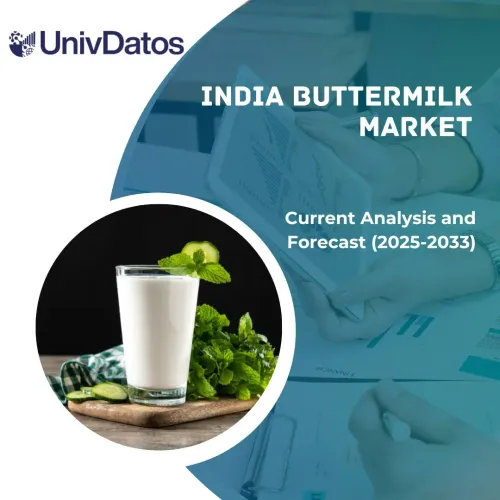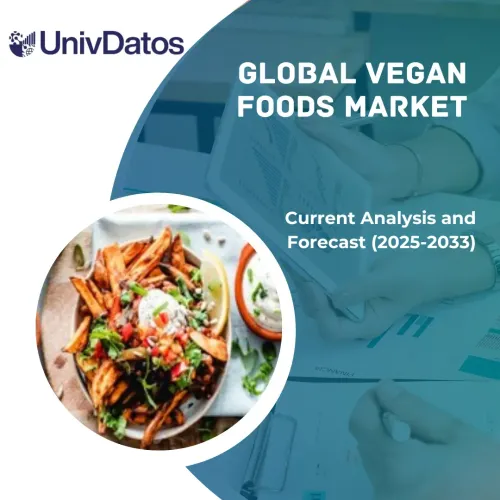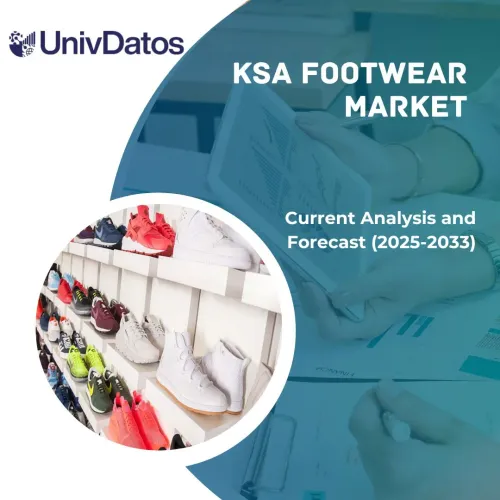- Strona główna
- O nas
- Branża
- Usługi
- Czytanie
- Kontakt
Rynek łańcucha chłodniczego: bieżąca analiza i prognoza (2021-2027)
Nacisk na zastosowanie (owoce i warzywa, nabiał i mrożone desery, ryby, mięso i owoce morza, piekarnia i cukiernia); Rodzaj temperatury (mrożony, chłodzony); Typ (transport chłodniczy, magazynowanie chłodnicze); Region/Kraj
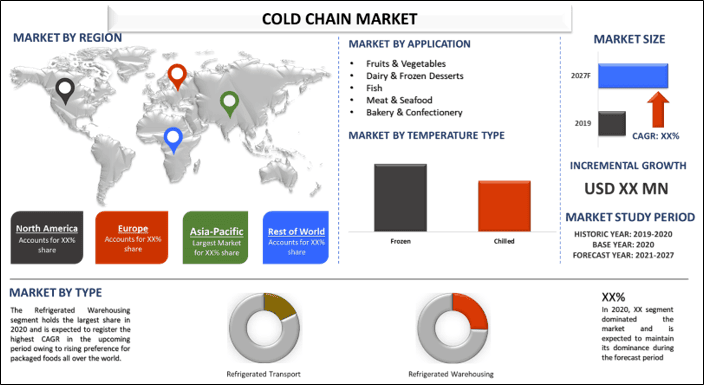 Oczekuje się, że rynek łańcucha chłodniczego będzie rósł w tempie CAGR wynoszącym ~8% w okresie prognozy (2021-2027).Łańcuch chłodniczy to mieszanka transportu powierzchniowego z kontrolowaną temperaturą i łańcucha dostaw. Odnosi się do rozwiązań mrożeniowych, które pomagają utrzymać jakość i okres przydatności do spożycia produktów, na przykład owoce morza, produkty rolne, mrożona żywność, chemikalia, filmy fotograficzne i leki farmaceutyczne. Obecnie łańcuchy chłodnicze są niezbędne do wydłużenia okresu marketingu, zmniejszenia wąskich gardeł transportowych w okresach szczytowych i zapobiegania nadwyżkom mocy produkcyjnej. Proces obejmuje eksploatację magazynów monitorowanych pod kątem temperatury do przechowywania i chłodni transportowych do dystrybucji produktów. Rozwiązania logistyczne łańcucha chłodniczego są szeroko stosowane do transportu i przechowywania warzyw, owoców, wołowiny, mięsa, leków i lekarstw. Ponadto stosuje się również różne rodzaje transportu, takie jak chłodzone wagony kolejowe, chłodnie, transport lotniczy, chłodzone ładunki.
Oczekuje się, że rynek łańcucha chłodniczego będzie rósł w tempie CAGR wynoszącym ~8% w okresie prognozy (2021-2027).Łańcuch chłodniczy to mieszanka transportu powierzchniowego z kontrolowaną temperaturą i łańcucha dostaw. Odnosi się do rozwiązań mrożeniowych, które pomagają utrzymać jakość i okres przydatności do spożycia produktów, na przykład owoce morza, produkty rolne, mrożona żywność, chemikalia, filmy fotograficzne i leki farmaceutyczne. Obecnie łańcuchy chłodnicze są niezbędne do wydłużenia okresu marketingu, zmniejszenia wąskich gardeł transportowych w okresach szczytowych i zapobiegania nadwyżkom mocy produkcyjnej. Proces obejmuje eksploatację magazynów monitorowanych pod kątem temperatury do przechowywania i chłodni transportowych do dystrybucji produktów. Rozwiązania logistyczne łańcucha chłodniczego są szeroko stosowane do transportu i przechowywania warzyw, owoców, wołowiny, mięsa, leków i lekarstw. Ponadto stosuje się również różne rodzaje transportu, takie jak chłodzone wagony kolejowe, chłodnie, transport lotniczy, chłodzone ładunki.
Sprzedaż wiodących restauracji typu Quick Service Restaurants w USA 2017, na sklep (w mln USD)
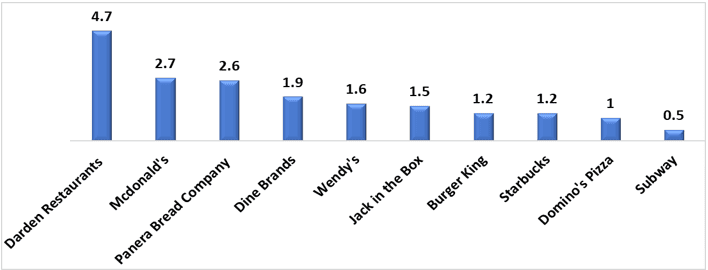
Wnioski przedstawione w raporcie
„Wśród zastosowań segment nabiału i mrożonych deserów zdominował rynek w 2020 r.”
W oparciu o zastosowanie rynek jest podzielony na owoce i warzywa, nabiał i mrożone desery, ryby, mięso i owoce morza oraz piekarnie i cukiernie. Segment nabiału i mrożonych deserów zdominował rynek w 2020 r. i oczekuje się, że będzie generował zyski w prognozowanym okresie. Segment nabiału i mrożonych deserów stanowi największą część rynku łańcucha chłodniczego. Produkty mleczne, takie jak mleko, od wieków wiązano z chorobami przenoszonymi przez żywność. Według Centers for Disease Control and Prevention, 48 milionów ludzi choruje, 128 000 trafia do szpitali, a 3000 osób umiera z powodu chorób przenoszonych przez żywność każdego roku w Stanach Zjednoczonych. Produkty mleczne są jednymi z najbardziej regulowanych produktów spożywczych. Logistyka łańcucha chłodniczego jest ważna dla utrzymania jakości produktów mlecznych. Łańcuch chłodniczy zapewnia zachowanie niskiej temperatury, wymaganej przez produkty mleczne, w całym łańcuchu dostaw.
„Wśród rodzaju temperatury segment mrożony ma główny udział.”
W oparciu o rodzaj temperatury rynek jest podzielony na mrożony i chłodzony. Segment mrożony zdominował rynek w 2020 r. i oczekuje się, że będzie generował zyski w prognozowanym okresie. Mrożenie żywności to konserwacja okresu przechowywania produktów spożywczych poprzez uczynienie ich bardziej obojętnymi. Ponadto proces mrożenia spowalnia reakcje biologiczne i chemiczne, które sprzyjają psuciu się żywności i ograniczają jej okres przydatności do spożycia. Produkty mrożone mają standardowy zakres temperatur od 18°C do -25°C. Mrożenie zachowuje teksturę, smak i wartość odżywczą produktów spożywczych. Chociaż zależy to również od rodzaju materiałów spożywczych, stosowania wstępnej obróbki, wyboru zamrażarki i opcji przechowywania w zamrażarce oraz użycia odpowiedniego opakowania
„Wśród typów segment magazynowania chłodniczego ma odnotować najwyższy wzrost CAGR.”
W oparciu o typ rynek jest podzielony na transport chłodniczy i magazynowanie chłodnicze. Segment magazynowania chłodniczego ma największy udział w 2020 r. i oczekuje się, że zarejestruje najwyższy CAGR w nadchodzącym okresie ze względu na rosnące preferencje dla pakowanej żywności na całym świecie. Zmiana wzorców żywieniowych i stylu życia konsumentów dodatkowo napędza popyt na mrożoną żywność, co z kolei zwiększa zapotrzebowanie na magazynowanie. Według GCCA całkowita pojemność chłodni na całym świecie wynosiła 616 milionów metrów sześciennych w 2018 r., o 2,67% więcej niż pojemność zgłoszona w 2016 r.
„Ameryka Północna to jeden z największych rynków.”
Aby lepiej zrozumieć adaptację rynku łańcucha chłodniczego, rynek jest analizowany w oparciu o jego obecność na całym świecie w krajach takich jak Ameryka Północna (Stany Zjednoczone, Kanada i reszta Ameryki Północnej), Europa (Niemcy, Francja, Hiszpania, Wielka Brytania i reszta Europy), Azja i Pacyfik (Chiny, Japonia, Indie, Australia i reszta APAC) oraz reszta świata. Azja i Pacyfik zdominują rynek łańcucha chłodniczego ze względu na rosnący rozwój gospodarczy takich krajów jak Chiny, Indie, Japonia i Australia. Przesunięcie industrializacji i inwestycji w regionie Azji i Pacyfiku znacznie wzrosło w ciągu ostatniej dekady, zwłaszcza w Chinach i Indiach, przyczyniając się do szybkiego wzrostu gospodarczego. Co więcej, wysoki popyt na produkty mleczne i mięsne w regionie Azji i Pacyfiku prowadzi do wysokiego zapotrzebowania na zachowanie jakości i elementów odżywczych w produktach, co napędza rynek łańcuchów chłodniczych w regionie. Niektórzy z głównych graczy działających na rynku to Americold Logistics, Lineage Logistics Holdings, Nichirei Corporation, Burris Logistics, Agro Merchants Group, Kloosterboer, United States Cold Storage, Tippmann Group, VersaCold Logistics Services i Henningsen Cold Storage Co. Kilka fuzji i przejęć wraz z partnerstwami zostało podjętych przez tych graczy w celu zwiększenia ich obecności w różnych regionach.
Powody, dla których warto kupić ten raport:
- Badanie obejmuje analizę rozmiaru i prognoz rynku zatwierdzoną przez uwierzytelnionych kluczowych ekspertów branżowych
- Raport przedstawia szybki przegląd ogólnych wyników branży na pierwszy rzut oka
- Raport zawiera dogłębną analizę wybitnych rówieśników branżowych, ze szczególnym uwzględnieniem kluczowych finansów biznesowych, portfolio produktów, strategii ekspansji i ostatnich wydarzeń
- Szczegółowe badanie czynników napędowych, ograniczeń, kluczowych trendów i możliwości panujących w branży
- Badanie kompleksowo obejmuje rynek w różnych segmentach
- Dogłębna analiza branży na poziomie regionalnym
Opcje dostosowywania:
Rynek łańcucha chłodniczego można dodatkowo dostosować do wymagań lub jakiegokolwiek innego segmentu rynku. Oprócz tego UMI rozumie, że możesz mieć własne potrzeby biznesowe, dlatego skontaktuj się z nami, aby uzyskać raport, który w pełni odpowiada Twoim wymaganiom.
Spis treści
Analiza historycznego rynku, oszacowanie obecnego rynku i prognozowanie przyszłego rynku globalnego rynku łańcucha chłodniczego były trzema głównymi krokami podjętymi w celu stworzenia i analizy adaptacji łańcucha chłodniczego dla różnych zastosowań. Przeprowadzono wyczerpujące badania wtórne w celu zebrania historycznych danych rynkowych i oszacowania obecnego rozmiaru rynku. Po drugie, aby zweryfikować te spostrzeżenia, wzięto pod uwagę liczne ustalenia i założenia. Co więcej, przeprowadzono również wyczerpujące wywiady pierwotne z ekspertami branżowymi w całym łańcuchu wartości sektora łańcucha chłodniczego. Po założeniu i walidacji danych rynkowych poprzez wywiady pierwotne, zastosowaliśmy podejście oddolne do prognozowania pełnego rozmiaru rynku. Następnie zastosowano metody podziału rynku i triangulacji danych w celu oszacowania i analizy wielkości rynku segmentów i podsegmentów, do których odnosi się branża. Szczegółowa metodologia jest wyjaśniona poniżej:
Analiza historycznego rozmiaru rynku
Krok 1: Dogłębne badanie źródeł wtórnych:
Szczegółowe badanie wtórne przeprowadzono w celu uzyskania historycznego rozmiaru rynku łańcucha chłodniczego za pośrednictwem wewnętrznych źródeł firmy, takich jaksprawozdania roczne i sprawozdania finansowe, prezentacje wyników, komunikaty prasowe itp.,oraz źródła zewnętrzne, w tymczasopisma, wiadomości i artykuły, publikacje rządowe, publikacje konkurencji, raporty sektorowe, baza danych stron trzecich i inne wiarygodne publikacje.
Krok 2: Segmentacja rynku:
Po uzyskaniu historycznego rozmiaru rynku łańcucha chłodniczego przeprowadziliśmy szczegółową analizę wtórną w celu zebrania historycznych informacji rynkowych i udziałów dla różnych segmentów dla głównych regionów. Główne segmenty uwzględnione w raporcie to zastosowanie, rodzaj temperatury, typ i region. Ponadto przeprowadzono analizy na poziomie kraju w celu oceny ogólnego przyjęcia łańcucha chłodniczego w każdym regionie.
Krok 3: Analiza czynników:
Po uzyskaniu historycznego rozmiaru rynku różnych segmentów i podsegmentów, przeprowadziliśmy szczegółowąanalizę czynnikóww celu oszacowania obecnego rozmiaru rynku łańcucha chłodniczego. Ponadto przeprowadziliśmy analizę czynników przy użyciu zmiennych zależnych i niezależnych, takich jak rosnące zapotrzebowanie na kontrolę temperatury w celu zapobiegania stratom żywności, wzrost handlu międzynarodowego ze względu na liberalizację handlu. Przeprowadzono również analizę strony popytu i podaży.
Oszacowanie i prognoza obecnego rozmiaru rynku
Bieżące szacowanie wielkości rynku:W oparciu o praktyczne wnioski z powyższych 3 kroków, doszliśmy do obecnej wielkości rynku, kluczowych graczy na rynku łańcucha chłodniczego i udziałów rynkowych segmentów. Wszystkie wymagane udziały procentowe, podziały i podziały rynku zostały określone przy użyciu wspomnianego powyżej podejścia wtórnego i zostały zweryfikowane poprzez wywiady pierwotne.
Oszacowanie i prognozowanie:Do oszacowania i prognozy rynku przypisano wagi do różnych czynników, w tym czynników napędzających i trendów, ograniczeń i możliwości dostępnych dla interesariuszy. Po przeanalizowaniu tych czynników zastosowano odpowiednie techniki prognozowania, tj. podejście oddolne, w celu uzyskania prognozy rynkowej na około 2027 r. dla różnych segmentów i podsegmentów na głównych rynkach na całym świecie. Metodologia badawcza przyjęta do oszacowania wielkości rynku obejmuje:
- Wielkość rynku branży, pod względem wartości (USD) i wskaźnik adaptacji łańcucha chłodniczego na głównych rynkach krajowych
- Wszystkie udziały procentowe, podziały i podziały segmentów i podsegmentów rynku
- Kluczowi gracze na rynku łańcucha chłodniczego pod względem oferowanych usług. Ponadto strategie wzrostu przyjęte przez tych graczy w celu konkurowania na szybko rozwijającym się rynku.
Walidacja wielkości i udziału w rynku
Badania pierwotne:Przeprowadzono dogłębne wywiady z kluczowymi liderami opinii (KOL), w tym z kierownictwem wyższego szczebla (CXO/VP, szef sprzedaży, szef marketingu, szef operacyjny i szef regionalny, szef kraju itp.) w głównych regionach. Następnie wyniki badań pierwotnych zostały podsumowane i przeprowadzono analizę statystyczną w celu udowodnienia przedstawionej hipotezy. Dane z badań pierwotnych zostały skonsolidowane z ustaleniami wtórnymi, przekształcając tym samym informacje w praktyczne wnioski.
Podział uczestników pierwotnych w różnych regionach
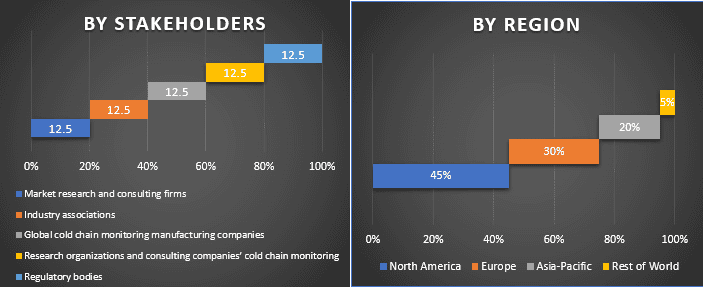
Inżynieria rynku
Technika triangulacji danych została wykorzystana do uzupełnienia ogólnej estymacji rynku i uzyskania precyzyjnych danych statystycznych każdego segmentu i podsegmentu rynku łańcucha chłodniczego. Dane zostały podzielone na kilka segmentów i podsegmentów po przestudiowaniu różnych parametrów i trendów w obszarach zastosowania, rodzaju temperatury, typu i regionu rynku łańcucha chłodniczego.
Główny cel badania rynku łańcucha chłodniczego
W badaniu określono obecne i przyszłe trendy rynkowe łańcucha chłodniczego. Inwestorzy mogą uzyskać strategiczne spostrzeżenia, aby oprzeć swoje decyzje inwestycyjne na analizie jakościowej i ilościowej przeprowadzonej w badaniu. Obecne i przyszłe trendy rynkowe zostały określone na podstawie ogólnej atrakcyjności rynku na poziomie regionalnym, zapewniając platformę dla uczestników przemysłu do wykorzystania niewykorzystanego rynku w celu uzyskania korzyści jako pierwszy gracz. Inne cele ilościowe badań obejmują:
- Analiza bieżącej i prognozowanej wielkości rynku łańcucha chłodniczego pod względem wartości (USD). Ponadto analiza bieżącej i prognozowanej wielkości rynku różnych segmentów i podsegmentów.
- Segmenty w badaniu obejmują obszary zastosowań, rodzaju temperatury, typu i regionu
- Definicja i analiza ram regulacyjnych dla branży łańcucha chłodniczego
- Analiza łańcucha wartości związanego z obecnością różnych pośredników, wraz z analizą zachowań klientów i konkurentów w branży
- Analiza bieżącej i prognozowanej wielkości rynku łańcucha chłodniczego dla głównych regionów
- Główne regiony objęte badaniem w raporcie obejmują Amerykę Północną (Stany Zjednoczone i Kanada), Europę (Niemcy, Francja, Hiszpania i Wielka Brytania), Azję i Pacyfik (Chiny, Japonia, Indie i Australia) oraz resztę świata
- Profile firm na rynku łańcucha chłodniczego i strategie wzrostu przyjęte przez graczy rynkowych w celu utrzymania się na szybko rozwijającym się rynku
- Dogłębna analiza branży na poziomie regionalnym
Powiązane Raporty
Klienci, którzy kupili ten przedmiot, kupili również




